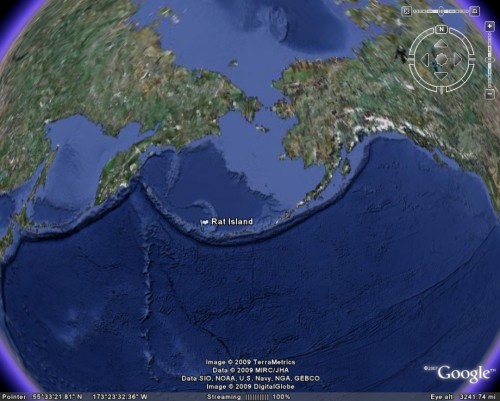
Google Earth view of Rat Island in the Aleutian Island chain
My summer field season is about to start. I’m leaving in a few days for Rat Island in the western Aleutian Islands. This will be a new project for me. I’m a “Senior Scientist” assisting Caroline Funk – a colleague of mine from graduate school days. Caroline has a grant from the US Fish and Wildlife Service to study archaeological middens on the island in order to understand how the accidental introduction of the Norway rat affected the island’s indigenous bird populations.
The USFWS is interested in this research because of the service’s recent efforts to eradicate rats from Rat Island. It’s a fascinating project. The rats arrived sometime before 1780 – apparently when a Japanese shipwreck landed on the island. The rapid-breeding and omnivorous rats devastated the island’s ecosystem – even affecting seaweed and shellfish in the intertidal zone. Birds are especially vulnerable because of the island’s treeless vegetation. With their nests on the ground or in burrows, the birds are easy prey for the invading rats. One biologist counted 140 auklet carcasses cached in a rat burrow on nearby Kiska Island – a testament to the potential damage the rats can bring. Rat Island’s auklets and other small sea birds have been nearly wiped out – leaving the island in an eery silence. With the rats gone, the USFWS plan to restore the island to its pre-rat condition. What they want from the archaeologists is historic data that will help them assess the impacts caused by the rat invasion.
Preliminary field work for the archaeology project began in 2003. USFWS archaeologist Debbie Corbett excavated a multi-component site on the island’s north side where she found a dramatic reduction of bird remains in the site’s midden assemblages during the Russian period. As Debbie and Caroline note, however, the cause of this decline can not be automatically blamed on the rats.
[I]t is also possible the people were focusing on different goals. Prehistoric folks would have been gathering all kinds of resources. Later Aleuts, hunting sea otters for the Russians, may have had less time or interest in hunting birds. This is a question that will have to be answered through more complete analysis.
The goal for the current research is to expand the sample size – including more sites and more components – so that we can better understand the relationship between birds remains, seasonality of occupation, economic activities, and other cultural practices. I’m looking forward to getting started. I just hope the rats have really been eradicated. I don’t want my tent over-run by the little critters like the scene from “Never Cry Wolf” (watch the last three minutes of this clip if you don’t know what I mean).



Hey Jimmy Hoffman!!!!
How the heck are ya!!?? I got out in the field myself this summer for the first time since pogo 2001. Was out on the Kivalina with Bill, good times. shoot me an email we need to catch up
By: Ty Beck on August 15, 2009
at 9:51 am
[…] via: Old Dirt, Alaska Science Forum and ABC […]
By: Incoming! The World's 10 Worst Invasive Species | WebEcoist on December 15, 2009
at 1:02 pm